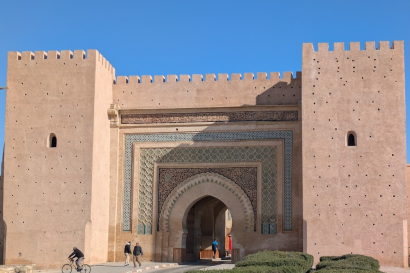After studying abroad in Morocco for more than 3 months, I found that although the public transportation usually cost significantly less than how much it’d cost in the U.S, one can still get ripped off if they’re not familiar with how the transportation system operates. Here I share my thoughts and tips on different means of transportation.
Small Taxi
Small taxis are probably the most popular means of transportation among IES Abroad students. Each taxi can take three passengers maximum, and in most cases, the driver has to turn on the kuntur (meter) as soon as the passengers enter the taxis. The price on the meter starts from 1.4 dirhams (15 cents) and they’re very affordable. In big cities such as Marrakech, the driver sometimes does not turn on the meter and tries to rip off tourists with little knowledge about small taxis in Morocco after the ride is completed. Make sure to say “khadam kuntur 3fak” (please turn on the meter) if the driver does not turn it on. I’ve had drivers being very aggressive with me after the ride and tried to ask me for more money even though I answered in Darija and told them how much it actually costs on the meter. Make sure to always have enough coins with you, leave the exact change, and get out of the taxi, no matter how aggressive the drivers are trying to rip you off.
Outside the Casablanca airport, there is no small taxis because it is technically outside the city. There are only tourist taxis and one needs to negotiate the price before getting on the taxi. A good price from the airport to the city is 200-250 dirhams, according to my Moroccan friend who lives in Casablanca. But when I tried to get a taxi at night from the Casablanca airport, the drivers, upon seeing me, asked for 800 dirhams.
In Essaouira (my favorite city in Morocco!), taxi drivers do not use a meter because the city itself is very small. No matter where you go in the city, it always costs 7 dirhams during the day and 8 dirhams at night.
Big, Shared Taxi
This is definitely my favorite means of transportation. Big, shared taxis work like busses in the sense that they have their set routes that they always stick to, and one can get on the taxi, if there are available seats, and get off the taxi whenever they want. Not sure when they stop running but they run till pretty late at night. Everyone pays a flat rate, usually 5-6 Moroccan dirhams (approximately 50-60 cents). Taxi drivers usually wait until it’s full (with 6 people) before they start driving, so you might consider arriving on site a bit early before your desired departure time. There’s nowhere to find big taxi routes and stations online; locals know it from word of mouth or experience. Bab Chellah is a busy big taxi station, so you might ask around there and see if there’s any taxis going to the place you want to go. My favorite big taxi route is from Bab Chellah to the bus station Kamra. Since I solo travel by bus a lot and don’t usually have people to split a small taxi with, I usually take big taxis and spend 5 dirhams one way to the bus station.
Tram
Trams are not as fast as taxis but they’re very modern and comfortable. There are only two tram lines, L1 and L2. One can buy a ticket on the self-service machines or at the ticket office during its opening hours at the tram stations. One has the option of purchasing a tram pass that will end up being cheaper per ride if they take the tram very often or purchasing individual tickets for 6 Moroccan dirhams each; each ticket is valid for an hour and a half after activation and one needs to activate the ticket after getting on the tram. A ticket inspector will usually come around to check if everyone has a ticket and if each ticket has been activated. I only take the tram from Hassan Tour, the stop 3 minutes away from the IES Abroad Rabat center, when I go to the university class at University of Mohamed V every Monday. The law and economics faculty is near the tram stop called Nations Unis. I know there is another campus near the station Cite Universitaire.
Bus
I’ve never taken a bus before in Rabat because busses are usually very old and crowded. It costs 5 dirhams, slightly cheaper than the tram, but I usually go for the tram.
Intercity Bus/Train
Intercity trains are for sure the most used means of transportation among IES Abroad students. There is no need to purchase the tickets early; usually one or two days before departure are sufficient. Unless it’s during the spring break for all Moroccan students, in which case you’ll want to purchase the tickets early. First class costs more than second class. I’ve never bought a first class ticket, but with a second class ticket you can get a seat in a compartment with 5 other people.
There are different intercity bus providers and one can haggle with the ticket sellers. However, some busses can be a bit dangerous because they don’t go on the safer highway and drive too fast. CTM bus company is the best, usually with a spacious waiting room and a bathroom. The CTM bus station is 5 minutes away on foot from the Kamra bus station, but you can purchase the tickets at Kamra.
Hope this is helpful for the students coming to study in Rabat! When in doubt, definitely ask the center staff, your host family, or your Moroccan friends for advice!
Please note that IES Abroad advises students not to take grand taxis beyond the city of Rabat.

Chen Yu
<p>Speaking fluent Mandarin Chinese, English, and conversational Czech, Yu Chen is currently looking to perfect his French during his upcoming semester abroad in Rabat. Passionate about revealing social and structural inequalities around the world through film and media, Yu Chen is pursuing a bachelor’s degree in Gender & Sexuality Studies and Digital Media Production.</p><p>Previously, Yu Chen has studied environmental issues in Okinawa, conducted research on social practice art in Puerto Rico, exchanged at the Film & TV School of Academy of Performing Arts in Prague, and tasted 44-year-old homemade Serbian Rakija in Belgrade.</p>








